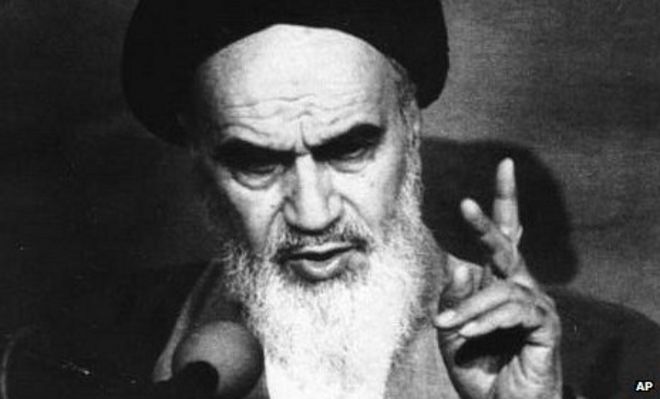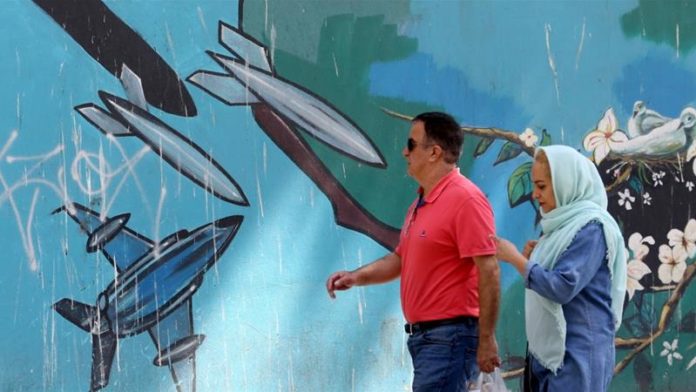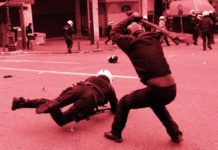On November 4th of this year, it will have been exactly forty years since Iranian students seized the American Embassy in Tehran and took hostage more than 50 Americans. Holding them for 444 days. Thus started the trajectory leading us to June 20th of 2019 where an American Global Hawk surveillance drone was shot down by Iran’s Islamic Revolutionary Guard.

Four decades later, the relationship between Iran and the United States has never been the same.
Prior to November 1979, Iran was on a trajectory of modernization under the then Shah Mohammad Reza Pahlavi whom we’ve come to just call the Shah of Iran. It was a westernization that started with his father, Reza Shah Pahlavi, decades earlier. The son, Pahlavi, was a secular Muslim and his interest in oil led him to a closer relationship to western nations. This did not wash with the otherwise conservative, devout element of Iranian society.
A modernizing Iran had long done away with the requirement of a woman wearing a hijab and life in Iran was starting to mirror that of a more secularized United States. Urban Iran was growing as the rural Iranians were moving to the cities to join the modernizating of the nation.
Though not perfect by western standards, women still were limited in education and employment, it was a movement away from the strict culture that preceded it.

What happened?
Indecision. Indecision was central to the modernizing downfall of Iran. Additionally sprinkled with a solid helping of the Shah’s autocracy.
The problem partially stemmed from the Shah’s near total inability to make significant decisions, but according to AP writer Jon Gambrell, regarding Shah Pahlavi, “As the economy improved, the shah increasingly seized more and more power. Everything down to the minutiae of the state needed to pass his desk. And slowly, he lost control by trying to take all of it.”
Change is disruptive and though in the western world, modernization is seen as a positive force, the largely Persian Shia nation did not always see it this way.
The balance of power in Iran had always been a bit tenuous in the 20th century. Though the Pahlavi (Shah) family had been ruling Iran for greater than a century, in 1951, the Shah had selected Mohammad Mossadegh to become Prime Minister of the nation in an effort to quell the instability wrought by both the westernization in progress and the nation’s dislike of the Brit’s control of the Anglo-Iranian Oil Company.
Instead of calming the nation’s politics, Mossadegh began to limit the Shah’s power and assume more power for the Prime Ministership. Since this was antithetical to the U.K.’s oil interests, Britain enlisted the CIA in a coup of Mossadegh in 1953.
Following this, according to the Council on Foreign Relations, “The shah repressed Iran’s Islamists, however, and his restoration fostered anger among the general population. By 1979, this discontent boiled over into outright revolution, forcing the shah to flee.”

The revolution was more than simply Shia muslim. It included both outright communists and other secular groups. However, with the return of Ayatollah Ruhollah Musavi Khomeini from exile in Iraq, the Ayatollah wrested control and Iran then became an Islamic nation. Followed by the continuing unrest that led to the hostage crisis.
How did indecision play a part?
Simply put, the Shah and the west could never decisively act. The Shah, as repeated by Stanford’s Abbas Milani, was, “…almost Hamlet-like in his indecision.”
Relevant to today’s events, it was President Jimmy Carter’s administration that puts the United States squarely in the position is it now in. It still boils down to trajectory. Administrations following the Shah’s downfall have had little success in change the Iranian path.

As a nuclear training Naval officer and successful peanut farmer, Jimmy Carter was an impressive man. He was a man of his convictions. Even when misguided.
Like many liberals, Carter ascribed to a theory that the United State should not be the preeminent world leader but as a nation that should ‘find its place’ amongst the other countries around the globe. This sentiment was echo’d in his selection of Cyrus Vance as his Secretary of State.
Vance was more prone to negotiation than to action. Moreover, that the threat of action was destabilizing. His resignation as a reaction, and opposition, to the military rescue attempt of the American Hostages. In the twilight of his Presidency, Carter finally realized action was needed and Vance did not agree and resigned.
Indecisiveness.
Like 1979, in 2009, Iran was in the midst of another upheaval. On the heals of a questionable election of Mahmoud Ahmadinejad as Iranian president, grew what was called the Green Revolution. A revolution borne out if Iranian citizens distrust of the presidential election results.

As a moderate reformist of Iran’s hardline policies, candidate Mir-Hossein Mousavi represented a will within the nation to move to greater personal freedom. Though by American standards, he wouldn’t be considered a liberty-minded western liberal, he did represent change in Iran.
As unrest began to build, the United States was in a position to affect change in Iran. To support a revolution beneficial to the western world. There was only one problem:
Barack Obama was president.
From the moment the Obama administration assumed office, their want for a deal with the republic was, in my opinion, single-minded and absent any strategic benefit. Obama wanted a deal for a deal’s sake. Remember, this is the president that called to the White House historians to ask what would make him transformational. Obama wanted a victory lap but simply stumbled through this race.
Obama also believed that ‘Americas should have its place’.
According to Jay Solomon in his book ‘Iran Wars’ regarding the CIA “The Agency has contingency plans for supporting democratic uprisings anywhere in the world. This includes providing dissidents with communications, money, and in extreme cases even arms…But in this case the White House ordered it to stand down.”
All in the name of a so-called deal, he did nothing.

Oh, hey. What about that Iranian deal?
So desperate to be transformative; Obama, also in the twilight of his administration, wanted a deal, any deal, from Iran.
Strutted about as a nuclear arms treaty, the Obama-Iran nuclear deal was meant to lead Iran down the path of nuclear disarmament. Only one problem: It had zero enforcement. The agreement did say there would be inspections….with enough warning to Iran….and off limits to certain nuclear facilities. Which is to say; there was no enforcement of the deal. It was a merely signed document.
Followed with a bribe to Iran of over a billion dollars….and 400 million dollars in cash shipped directly to Iran on pallets.
Funny about those pallets of cash, shipped at the same time the deal was signed, the Obama people pretended the cash had nothing to do with the nuclear agreement. It was for “…interest on the settlement of a 1979 arms deal between the two countries immediately before the Islamic Revolution…the Obama Administration airlifted the $400 million in euros and Swiss francs on pallets.” followed with, “Tehran released four American prisoners on the exact same day.”
Because that makes the pallets of lucre an even better deal? To satisfy an agreement that predated the current regime? A regime that overthrew the last?
I’ve heard better excuses from high schoolers out beyond curfew.

Fast forward to this previous Thursday where Iranians shot down the U.S. drone.
On the heels of U.S. allies oil taker being bombed, the Trump administration stepped up the American military presence on the Strait of Hormuz. Further, U.S. Secretary of State Mike Pompeo placed responsibility on Iran, further stating, “Taken as a whole, these unprovoked attacks present a clear threat to international peace and security, a blatant assault on the freedom of navigation and an unacceptable campaign of escalating tension by Iran”
If such attacks were in isolation, Iran’s action would not be excusable but considered in a different light than what the United States sees currently. Iran has been both a bad actor in the middle east overall and a specific supporter of Islamic terrorism.
Iran’s leadership, in its current form, does not and will never be a nation of peace. This is the Iran that funds terrorism throughout the middle east, calls for the end of Israel (including funding Hezbollah) and overall death to the west.
Many in the mostly leftist press believe that Trumps tearing up of the Obama-Iran agreement has emboldened the Islamic nation stating that a compliant Iran to that agreement was a docile Iran.
Except they weren’t. The nation still sponsored terror and still was a bad actor in the region.
The problem for Trump is the balance to act decisively. Trump is not prone to go to war and involve the U.S. in another middle eastern conflict. He campaigned on this. It’s likely the decision to halt an attack on Iranian assets had this in mind. Planes were in the air ready to pull the trigger but were recalled.
From the rescinding the the Obama-Iran agreement, the Trump administration has been engaged in a sanction battle with Iran. Much of what you see is a desperate Iran needing to act in some way.
Via a Vox interview, naval expert Afshon Ostovar stated, “So the United States, by having a maximum pressure campaign…Iran, on the other hand, has said that it’s not going to talk until sanctions are lifted.”
It is something of a stalemate. The Trump administration wishes to compel negotiation via pressure, not capitulating a la Obama. Iran is refusing. Still, Iran suffering under sanctions is taking actions to combat the effects of the sanction’s financial pressures.
Donald Trump stands at a similar place as Carter in 1979 and Obama on 2009. What action will Trump take? History tells us that inaction has only emboldened Iran but history has also told us that military action in the middle east has been a quagmire for the U.S..
There is no clean answer. There never was. Though better opportunities were available to resolve the Iran issue for both Carter and Obama, they did nothing. Allowing Iran to only deepen its roots in the middle east.
Trump gets the result of all this inaction and has yet to determine a clear course of action.
He should decide…and soon. The trajectory cannot sustain.

























“Obama, also in the twilight of his administration, wanted a deal, any deal, from Iran.”
It is much easier and more consistent to simply acknowledge that Obama wanted to harm the United States. Every policy proposal, every legislative proposal or Executive Order, every public proclamation, every single thing — pointed the country in the wrong direction: toward bankruptcy, internal division, a smaller future, and diminished influence.
My thought is that Obama and the like don’t like a strong U.S. and have been drilled on the evil of the imperialist U.S.. Is that harm? Ultimately it is. It’s Obama’s worldview that America is not unique despite history telling us otherwise. His decisions were near universally wrong. Was it to intentionally harm the U.S.? Not sure but it is out of ignorance that his bad decisions were made.
President Trump denies that assets were “in the air.” He claims that he decided against a retaliatory strike before any assets were mobilized. Is he lying?
I always wrestle with Trump’s verbal inaccuracy. This is what he’d said at the time of writing the post so I’ll roll with it but I’m also prone to think that the military was standing at the ready at the very least. Trump’s verbal style makes it hard to call what’s he’s saying as a lie but more likely stretching the actual truth.